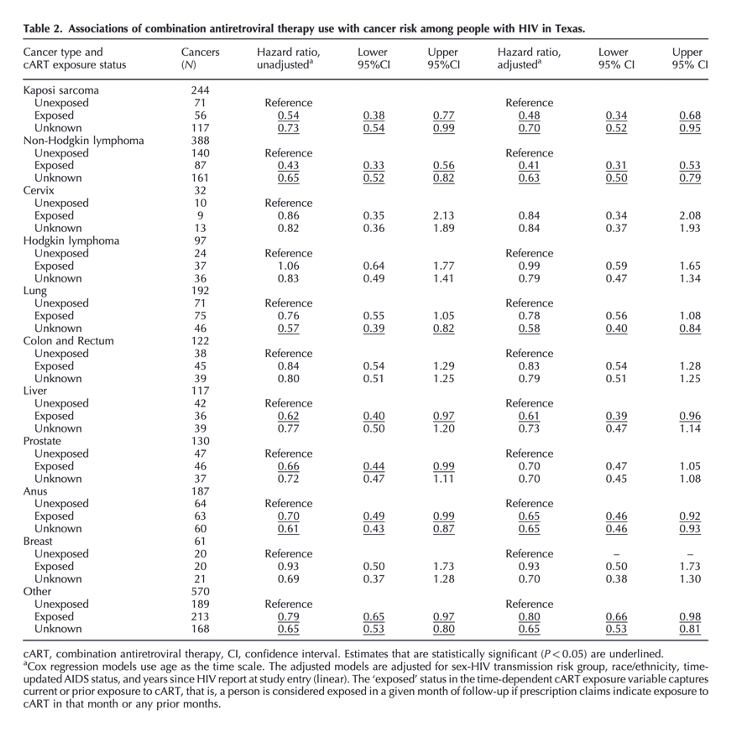| |
Real-world use of antiretroviral therapy
and risk of cancer among people with HIV in Texas, Commentary
|
| |
| |
Download the PDF here
Download the PDF here
From Commentary attached:
Patients with ART-exposed status within this study had 50-60% reduction in Kaposi sarcoma and NHL risk as compared with those who were unexposed [9]. There was also a 30-40% decrease in liver and anal cancers in those who were ART-exposed. Other cancers that continue to increase among PWH, such as lung cancer and Hodgkin lymphoma, were not different between exposed and unexposed groups. With regards to other virus-associated cancers, though decrease in anal cancer was observed, cervical cancer risk, also caused by human papillomavirus, was not different. This is discrepant from a large cohort study from France demonstrating a 50% decrease in cervical cancer with use of ART for more than 6 months [10]. The longitudinal relationship between several factors such as viral control, immunosuppression, inflammation and how these factors change at HIV diagnosis, ART initiation and cancer onset require further investigation. In addition to ART prescribing, real-world studies need to also consider the uptake and benefit of other preventive measures available to the general population, such as cancer screening and vaccination to determine the impact of cancer prevention approaches for PWH with elevated cancer risk as they age.
------------------------
HIV viral suppression and immune reconstitution through cART are central to cancer prevention among PWH and may account for declines in cancer incidence.
Cancer risk is elevated among PWH [5], partly because of loss of immunologic control of oncogenic viruses, including Kaposi sarcoma-associated herpesvirus (etiologically relevant for Kaposi sarcoma), Epstein-Barr virus (NHL and Hodgkin lymphoma), human papillomavirus (cervical and anal cancers), and hepatitis B and C viruses (liver cancer). Risks of some of these cancers increase with higher HIV viral load and/or lower CD4+ count [12]. Anal cancer risk increases among PWH with prolonged high-level HIV replication and low CD4+ counts (especially after a lag of several years) [12], highlighting the importance of long-term immunosuppression [12,21].
In conclusion, in a large HIV cohort incorporating data from prescription claims, we found that cART use was associated with greatly reduced risks of Kaposi sarcoma and non-Hodgkin lymphoma, and to a lesser degree, reduced risks of liver and anal cancers. These associations likely reflect the beneficial effects of HIV suppression and improved immune control of oncogenic viruses. Despite major declines in cancer risk among PWH over the past 20 years, risk remains elevated compared with the general population [5]. More widespread cART use with sustained adherence offers an important opportunity to further reduce cancer incidence among PWH.
the reduced risks that we observed for Kaposi sarcoma and NHL with cART use plausibly reflect the effects of improved immune function. These reduced risks may also partly reflect other benefits of regular access to medical care.
During follow-up, 2137 PWH were diagnosed with cancer, including 1570 cancers at the 10 sites of interest. The most common cancers were NHL (N = 388), Kaposi sarcoma (N = 244), lung cancer (N = 192) and anal cancer (N = 187). As described above in the Methods, we analyzed cancer risk using an alternative time-dependent variable for cART exposure that assumed that a person was exposed to cART in all months after an initial cART-exposed month. Using this approach (Table 2), cART exposure was associated with significantly reduced risks for Kaposi sarcoma (aHR 0.48, 95% CI 0.34-0.68, compared to unexposed follow-up time), NHL (aHR 0.41, 95% CI 0.31-0.53), liver cancer (aHR 0.61, 95% CI 0.39-0.96), anal cancer (aHR 0.65, 95% CI 0.46-0.92), and the miscellaneous group of ‘other’ cancers (aHR 0.80, 95% CI 0.66-0.98). In contrast, cART-exposed status was not associated with risk for cervical, lung, colorectal, prostate or breast cancers. Finally, there was reduced cancer risk associated with unknown cART exposure status for Kaposi Sarcoma, NHL, lung cancer, anal cancer and ‘other’ cancers.

|
|
| |
| |
|
|
|